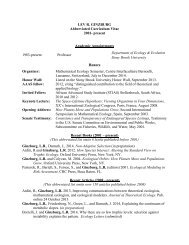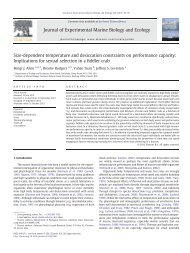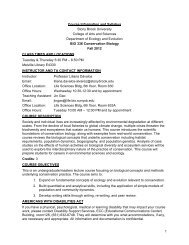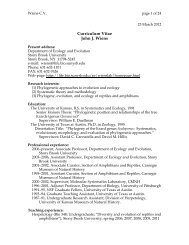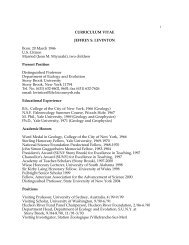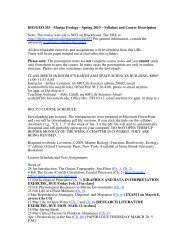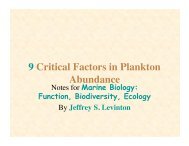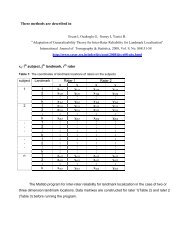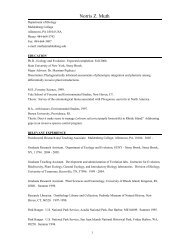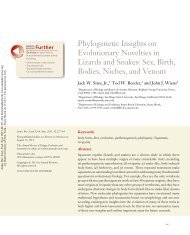Two New Species of Scincid Lizards
Two New Species of Scincid Lizards
Two New Species of Scincid Lizards
You also want an ePaper? Increase the reach of your titles
YUMPU automatically turns print PDFs into web optimized ePapers that Google loves.
<strong>Two</strong> <strong>New</strong> <strong>Species</strong> <strong>of</strong> <strong>Scincid</strong> <strong>Lizards</strong><br />
(Squamata) from the Massif de Kopéto,<br />
<strong>New</strong> Caledonia<br />
Ross A. Sadlier, Aaron M. Bauer, Anthony H. Whitaker<br />
and Sarah A. Smith<br />
Reprinted from the<br />
Proceedings <strong>of</strong> the California Academy <strong>of</strong> Sciences<br />
Volume 55, No. 11, pp. 208-221. April 22, 2004
Reprinted from PCAS vol. 55, nos. 1–12, pp. 1–254 (22 April 2004).<br />
PROCEEDINGS OF THE CALIFORNIA ACADEMY OF SCIENCES<br />
Volume 55, No. 11, pp. 208–221, 10 figs. April 22, 2004<br />
<strong>Two</strong> <strong>New</strong> <strong>Species</strong> <strong>of</strong> <strong>Scincid</strong> <strong>Lizards</strong> (Squamata)<br />
from the Massif de Kopéto, <strong>New</strong> Caledonia<br />
Ross A. Sadlier 1, Aaron M. Bauer 2,4, Anthony H. Whitaker 3 and Sarah A. Smith 2<br />
1 Section <strong>of</strong> Herpetology, Australian Museum, 6 College Street, Sydney 2000, NSW, Australia; email:<br />
rosss@austmus.gov.au; 2 Department <strong>of</strong> Biology, Villanova University, 800 Lancaster Avenue, Villanova,<br />
Pennsylvania 19085, USA; email: aaron.bauer@villanova.edu and sarah.a.smith@villanova.edu.; 3 270<br />
Thorpe-Orinoco Road, Orinoco, RD 1, Motueka 7161, <strong>New</strong> Zealand; email: whitaker@ts.co.nz<br />
Field research in the ultramafic peaks <strong>of</strong> northwest <strong>New</strong> Caledonia has resulted in<br />
the discovery <strong>of</strong> two new species <strong>of</strong> scincid lizard from the Massif de Kopéto. One is<br />
a surface active species <strong>of</strong> moderate size that on the basis <strong>of</strong> genetic and morphological<br />
criteria is recognized as the sister species to Lioscincus steindachneri Bocage (the<br />
type species <strong>of</strong> the genus). The other species belongs to the genus Nannoscincus, a<br />
group <strong>of</strong> diminutive, elongate, small-limbed, burrowing species. Both are so far only<br />
known from relatively high elevation closed forest on the Massif de Kopéto, an area<br />
actively mined for nickel. Both species are considered to be <strong>of</strong> particular conservation<br />
concern due to their apparently restricted distribution, and the potential threat<br />
to their preferred habitat from mining activities.<br />
Prior to the 1980s, the herpet<strong>of</strong>auna <strong>of</strong> <strong>New</strong> Caledonia was very poorly known. Virtually all<br />
<strong>of</strong> the systematic and distributional data available were derived from the research <strong>of</strong> Roux (1913)<br />
or earlier workers, and additional small collections <strong>of</strong> material were made only sporadically in the<br />
intervening decades, resulting in the description <strong>of</strong> only a few new taxa (see review in Bauer and<br />
Sadlier 2000). During the period between 1980–2000 many new lizard species and several new<br />
genera were discovered and described, bringing the number <strong>of</strong> recognized lizard taxa in <strong>New</strong><br />
Caledonia to 68, <strong>of</strong> which 61 are endemic (Bauer and Sadlier 2000). This increase resulted largely<br />
from an extensive program <strong>of</strong> targeted field research that sampled humid and sclerophyll forests<br />
as well as maquis vegetation at all elevations. Much <strong>of</strong> this field research focused on the rich lizard<br />
fauna found in the humid closed forests <strong>of</strong> the axial mountain chain that runs nearly the full length<br />
<strong>of</strong> the main island, the Grand Terre. Recent expeditions to mid- and high-elevation sites within the<br />
major forest blocks have led to the description <strong>of</strong> many new taxa with highly restricted distributions<br />
(e.g., Bauer et al. 1998, 2000; Sadlier et al. 1998; Sadlier and Bauer 1999, 2000), indicative<br />
<strong>of</strong> the extensive microendemism that characterizes most <strong>of</strong> the <strong>New</strong> Caledonian herpet<strong>of</strong>auna<br />
(Bauer and Sadlier 1993, 2000; Bauer 1999).<br />
Despite this effort, much <strong>of</strong> <strong>New</strong> Caledonia remained herpetologically unexplored. In particular,<br />
the series <strong>of</strong> large, isolated ultramafic peaks on the northwest side <strong>of</strong> the island constituted one<br />
<strong>of</strong> the most poorly known areas in <strong>New</strong> Caledonia. These massifs are substantially drier than the<br />
axial ranges on metamorphic rock that parallel them to the east (Paris 1981; Sautter 1981) and they<br />
support a rich and distinctive flora (Jaffré 1974; Jaffré and Latham 1974). They are mostly covered<br />
by maquis shrubland, a vegetation formation that has evolved to cope with the toxic, mineral-rich<br />
4 Research Associate, Department <strong>of</strong> Herpetology, California Academy <strong>of</strong> Sciences<br />
208
SADLIER, BAUER, WHITAKER, AND SMITH: NEW CALEDONIAN SKINKS 209<br />
soils, but at higher elevations have remnant patches <strong>of</strong> moist forest, characterized by numerous<br />
emergent Araucaria (Jaffré 1980; Morat et al. 1986; Jaffré et al. 1987).<br />
In 2001 a field program was initiated in Province Nord, Grande Terre, to determine the lizard<br />
species composition and conservation significance in various habitats, including the remnant moist<br />
forests on the major ultramafic peaks in the northwest. These are, from south to north, the Massif<br />
du Boulinda (1330 m), the Massif de Kopéto (1083 m), the Massif de Koniambo (940 m), the<br />
Massif d’Ouazangou-Taom (1092 m), Mont Kaala (1079 m), Dôme de Tiébaghi (599 m), and<br />
Sommet Poum (414 m). Although maquis vegetation extends to the tops <strong>of</strong> nearly all these peaks,<br />
small and highly fragmented forest patches also remain despite <strong>of</strong>ten intensive mining activity. All<br />
<strong>of</strong> these massifs were visited by one or more <strong>of</strong> the authors during the period 2001–2003. This survey<br />
effort resulted in a number <strong>of</strong> significant finds, all <strong>of</strong> which indicate the lizard fauna <strong>of</strong> these<br />
ultramafic peaks has a complex evolutionary history similar to that <strong>of</strong> the fauna <strong>of</strong> the humid<br />
forests <strong>of</strong> the central and north-eastern ranges <strong>of</strong> <strong>New</strong> Caledonia.<br />
Among the more interesting lizards obtained in the course <strong>of</strong> this research were specimens <strong>of</strong><br />
two new species <strong>of</strong> skink in the<br />
genera Lioscincus and Nannoscincus,<br />
both <strong>of</strong> which were collected<br />
from, or in the immediate<br />
vicinity <strong>of</strong>, small patches <strong>of</strong> remnant<br />
high elevation (>700 m) forest<br />
on the Massif de Kopéto (Fig.<br />
1), on the west <strong>of</strong> the Grande<br />
Terre.<br />
The Massif de Kopéto, and<br />
the contiguous peak Paéoua<br />
(1144 m), are separated from the<br />
Massif de Koniambo to the north<br />
by the broad valleys <strong>of</strong> the Koné<br />
and Pouembout Rivers, from the<br />
Massif du Boulinda to the south<br />
by the deep valley <strong>of</strong> the Népoui<br />
FIGURE 1. Map <strong>of</strong> <strong>New</strong> Caledonia showing location <strong>of</strong> Massif de Kopéto,<br />
type locality for Lioscincus vivae, sp. nov. and Nannoscincus manautei sp.<br />
nov.<br />
River, and from the axial ranges by the low-lying, hill country around Forêt Plate. This area has<br />
been discussed and figured by Holloway (1979). Like other northwestern massifs, the vegetation<br />
<strong>of</strong> Kopéto exhibits distinct elevational stratification (Jaffré 1974; Jaffré and Latham 1974).<br />
Elevations above 700 m are characterized by maquis vegetation dominated by species <strong>of</strong><br />
Costularia, Hibbertia, Knightia, Dicranopteris, Gahnia, and Grevillea, but patches <strong>of</strong> humid forest<br />
are also present (Fig. 2). These may be dominated by podocarps, myrtaceous or lauraceous<br />
trees, or by species <strong>of</strong> Casuarina, Metrosideros, Noth<strong>of</strong>agus, or Araucaria. The 20-year mean<br />
annual rainfall for the summit region <strong>of</strong> the Massif de Kopéto is 1830 mm (982–3288 mm), with<br />
a marked wet season from December to March (60% <strong>of</strong> annual rainfall, monthly mean 270.4 mm<br />
vs dry season monthly mean <strong>of</strong> 93.5 mm). Clouds to ground level enshroud the summit for 20%<br />
<strong>of</strong> the time. Temperatures average around 20°C, with extremes rarely dropping below 10°C or<br />
exceeding 30°C.<br />
MATERIAL AND METHODS<br />
MORPHOLOGY.— Specimens examined were from the collections <strong>of</strong> the Australian Museum<br />
(AMS), California Academy <strong>of</strong> Sciences (CAS), and Muséum National d’Histoire Naturelle, Paris
210 PROCEEDINGS OF THE CALIFORNIA ACADEMY OF SCIENCES<br />
Volume 55, No. 11<br />
FIGURE 2. Isolated closed forest patch on the Massif de Kopéto typical <strong>of</strong> habitat in the area from which the types <strong>of</strong><br />
Lioscincus vivae, sp. nov. and Nannoscincus manautei, sp. nov. were collected.<br />
(MNHN). Radiographs were prepared using a Eresco AS2 X-ray machine to determine phalangeal<br />
formulae and the number <strong>of</strong> presacral vertebrae and postsacral vertebrae (complete original tails<br />
only) with exposures <strong>of</strong> 40 sec at 40 kV.<br />
The full suite <strong>of</strong> morphological characters listed below was scored for each specimen. The following<br />
mensural features were recorded: snout to vent length (SVL), measured from tip <strong>of</strong> snout<br />
to caudal edge <strong>of</strong> anal scales; axilla to groin distance, measured from middle <strong>of</strong> base <strong>of</strong> forelimb<br />
to base <strong>of</strong> hindlimb; forelimb to snout length, measured from tip <strong>of</strong> snout to middle <strong>of</strong> base <strong>of</strong> forelimb;<br />
hindlimb length, measured from middle <strong>of</strong> base <strong>of</strong> hindlimb to tip <strong>of</strong> fourth toe including nail;<br />
tail length unless otherwise stated is measured from caudal edge <strong>of</strong> anal scales to tip <strong>of</strong> tail, on complete<br />
original tails only as determined by radiographs. Body measurements are expressed as percentages<br />
<strong>of</strong> snout to vent length in the taxon accounts.<br />
Head scalation generally follows Taylor (1935) as described and figured by Sadlier (1986).<br />
The following meristic characters were recorded: midbody scale rows = number <strong>of</strong> longitudinal<br />
scale rows around body counted midway between axilla and groin; paravertebral scales = number<br />
<strong>of</strong> scales in a paravertebral row from first scale posterior to parietal scale (including nuchals) to last<br />
scale at level <strong>of</strong> vent opening; fourth finger and toe scales = number <strong>of</strong> dorsal scales on fourth digit<br />
<strong>of</strong> hand and foot, distal scale contains claw; basal scale is last largely undivided scale at, or proximal<br />
to, a point level with intersection <strong>of</strong> the third and fourth digits (variably present as a single<br />
large scale common to the base <strong>of</strong> the fourth, third, and second fingers in some Nannoscincus),<br />
basal scale <strong>of</strong> fourth toe broadly contacts basal scale <strong>of</strong> adjacent third toe; fourth finger and toe<br />
lamellae = number <strong>of</strong> ventral scales on fourth digit <strong>of</strong> hand and foot, distal scale contains claw and<br />
basal scale is last largely undivided scale at a point level with intersection <strong>of</strong> third and fourth digits.<br />
Bilateral scalation characters were scored on both sides and the mean value used. Means <strong>of</strong><br />
variable mensural and meristic features are reported with their standard deviations.
SADLIER, BAUER, WHITAKER, AND SMITH: NEW CALEDONIAN SKINKS 211<br />
MOLECULAR ANALYSIS.— As part <strong>of</strong> a broad-scale phylogenetic study <strong>of</strong> the endemic reptiles<br />
<strong>of</strong> <strong>New</strong> Caledonia, we obtained mitochondrial and nuclear DNA sequences (514 bp <strong>of</strong> ND2 and<br />
830 bp <strong>of</strong> rag-1) from the majority <strong>of</strong> <strong>New</strong> Caledonian skink species (including all but one genus)<br />
and representatives <strong>of</strong> related lygosomine skink lineages from Australia, <strong>New</strong> Zealand, and Africa.<br />
This phylogenetic analysis includes representatives <strong>of</strong> all Lioscincus species with the exception <strong>of</strong><br />
L. greeri. ND2 sequences are available for all Nannoscincus except N. exos. Molecular data were<br />
analyzed within maximum parsimony and Bayesian frameworks using PAUP* v4 b10 (Sw<strong>of</strong>ford<br />
2000) and MrBayes v3 (Hulsenbeck and Ronquist 2001), respectively. Support for nodes on the<br />
optimal topologies was assessed using bootstrap and Bayesian posterior probability values.<br />
SYSTEMATICS<br />
Reptilia: Squamata: <strong>Scincid</strong>ae<br />
Lioscincus vivae Sadlier, Bauer, Whitaker, and Smith, sp. nov.<br />
(Figs. 3–7)<br />
TYPE MATERIAL.— HOLOTYPE: Muséum National d’Histoire Naturelle, Paris (MNHN)<br />
2003.1003 (formerly AMS R163227): Adult female; <strong>New</strong> Caledonia, Province Nord, Massif de<br />
Kopéto, Mont Vert, 21°10′22.4″S 165°02′14.6″E (altitude 720m), collected by A. H. Whitaker and<br />
V.A. Whitaker, 25 October 2002. PARATYPES: Australian Museum (AMS) R163228: Adult female;<br />
same collection data as holotype. AMS R163122: Adult male; <strong>New</strong> Caledonia, Province Nord,<br />
Massif de Kopéto, Mont Vert, 21°10′22.0″S 165°02′10.9″E (altitude 720m), collected by A.H.<br />
Whitaker and V.A. Whitaker, 20 June 2002. California Academy <strong>of</strong> Sciences (CAS) 226163:<br />
Juvenile; <strong>New</strong> Caledonia, Province Nord, Massif de Kopéto, Papainda 21°10′33″S 165°01′04″E<br />
(altitude 860m) collected by T. Jackman, A. Bauer, R. Sadlier, S. Smith, and G. Watkins-Colwell,<br />
21 January 2003.<br />
ETYMOLOGY.— The specific epithet is a matronym honoring Vivienne (“Viv”) Whitaker, who<br />
collected the holotype and two <strong>of</strong> the paratypes and who made a major contribution to our field<br />
research in northwestern Grand Terre. The name is feminine and is formed in the genitive singular.<br />
DIAGNOSIS.— Lioscincus vivae, sp. nov. can be distinguished from all other members <strong>of</strong> its<br />
genus except L. steindachneri by the following combination <strong>of</strong> characters: frontoparietals fused;<br />
anterior loreal elliptical and in narrow contact with upper labials; lower eyelid with an obvious,<br />
centrally located semi-transparent disc; each parietal scale bordered by an upper secondary temporal<br />
scale and two more or less similar sized scales not noticeably larger than adjacent dorsal scales;<br />
body scales smooth.<br />
Lioscincus vivae, sp. nov. is readily distinguished from Lioscincus steindachneri in having:<br />
anterior loreal contacting upper labials (vs usually present as a semilunar scale positioned <strong>of</strong>f postero-dorsal<br />
edge <strong>of</strong> enlarged nasal scale and failing to contact labials); labials below eye separated<br />
from contact with lower eyelid by a complete subocular row <strong>of</strong> scales (vs fifth upper labial scale<br />
contacting lower eyelid); more paravertebral scale rows (62–65 vs 57–60); color pattern distinctly<br />
two-toned with a white midlateral stripe anteriorly with a white midlateral stripe on head and neck<br />
(males) or full length (females) <strong>of</strong> body (vs a pattern <strong>of</strong> transverse bars with no white midlateral<br />
stripe).<br />
DESCRIPTION (based on holotype and thee paratype specimens including one adult male, two<br />
adult females, and one juvenile; measurements are for adult specimens only).— Measurements:<br />
SVL 53.5–55.0 mm; distance from axilla to groin 50.9–54.5% <strong>of</strong> SVL (x = 52.6); distance from<br />
forelimb to snout 40.0–43.0% <strong>of</strong> SVL (x = 41.9); hindlimb length 50.9–52.3% <strong>of</strong> SVL (x = 51.4);
212 PROCEEDINGS OF THE CALIFORNIA ACADEMY OF SCIENCES<br />
Volume 55, No. 11<br />
tail length 210.9% <strong>of</strong> SVL (estimated from<br />
individual with most complete tail).<br />
Scalation (Fig. 3): Nasals widely separated;<br />
frontonasal broader than long; prefrontals<br />
large and narrowly separated to narrowly<br />
contacting; supraciliaries usually 7<br />
(fused to give 5 on left and 6 on right in AMS<br />
R163228); supraoculars four; frontoparietals<br />
fused; interparietal distinct; parietals each<br />
bordered by a upper secondary temporal scale<br />
and two more or less similar sized scales not<br />
noticeably larger than the adjacent dorsal<br />
scales; upper labials 7; lower labials 6; loreals<br />
two, anterior loreal contacting the upper labials<br />
narrowly; complete subocular row <strong>of</strong><br />
9–12 scales (x = 10.25 ± 0.29) between preocular<br />
and pretemporal scales; primary temporal<br />
single; upper and lower secondary temporals<br />
single; tertiary temporals one (50%),<br />
or two; postlabials two; postmental contacting<br />
first and second lower labial; chinshields<br />
3, first pair in broad contact; body scales<br />
smooth, midbody scale rows 32–34 (x =<br />
32.75 ± 0.96); paravertebral scales 62–65 (x=<br />
62.75 ± 1.5); scales on top <strong>of</strong> fourth finger<br />
12–14 (x = 12.75 ± 0.96); lamellae beneath<br />
fourth finger 23–24 (x = 23.4 ± 0.48); scales<br />
on top <strong>of</strong> fourth toe 17–19 (x = 18.0 ± 1.00);<br />
lamellae beneath fourth toe 41–47 (x = 43.5 ±<br />
1.91).<br />
Coloration (in life): There is marked sexual<br />
dimorphism between the adult male and<br />
the adult females, with the juvenile similar in<br />
coloration to adult females.<br />
Adult male (Figs. 4–5): Dorsal surface <strong>of</strong><br />
body and tail uniform reddish brown, with<br />
indistinct paler middorsal stripe two half<br />
scales wide (noted at time <strong>of</strong> capture but not<br />
evident in accompanying photograph). Head<br />
gray-brown with numerous scattered dark<br />
spots on the dorsal headshields. Dorsolateral<br />
margin with a concentration <strong>of</strong> fine dark longitudinal<br />
flecks from just above the ear to just<br />
past the hindlimb. Lateral surface <strong>of</strong> anterior<br />
half <strong>of</strong> body two-toned, mid brown above<br />
FIGURE 3. Dorsal (upper), lateral (middle), and ventral<br />
(lower) views <strong>of</strong> the headshields <strong>of</strong> holotype <strong>of</strong> Lioscincus<br />
vivae, sp. nov. (MNHN 2003.1003). Scale bar = 1 mm.<br />
(not as red as dorsal surface) and pale gray below. Bold white midlateral stripe with narrow black<br />
margin above passing through the labials to the ear, and recommencing behind the ear but fading
SADLIER, BAUER, WHITAKER, AND SMITH: NEW CALEDONIAN SKINKS 213<br />
FIGURE 4 (above). Lateral view <strong>of</strong><br />
a paratype <strong>of</strong> Lioscincus vivae, sp.<br />
nov. (AMR 163122) in life showing<br />
adult male color pattern and the long<br />
tail characteristic <strong>of</strong> the species.<br />
FIGURE 5 (right). Lateral view <strong>of</strong><br />
the head a paratype <strong>of</strong> Lioscincus<br />
vivae, sp. nov. (AMR 163122) in life.<br />
towards the forelimb. Remainder <strong>of</strong> the lateral surface <strong>of</strong> the body (between the fore- and<br />
hindlimbs) grading from brown to gray (breaking into obscure pale blotches) towards the ventral<br />
surface. Side <strong>of</strong> head with numerous dark scattered spots to the headshields, and median and posterior<br />
labials each with large dark spots centered where the white midlateral stripe passes.<br />
Undersurface white, the throat and chest with fine, scattered, dark flecks.<br />
Adult females (Figs. 6–7): Dorsal surface reddish brown (as for adult males, but lacking middorsal<br />
stripe). Bold, white, dorsolateral stripe (2/3 scale width), dark-edged (broken) above from<br />
in front <strong>of</strong> the forelimb to just past the hindlimb. Lateral surface two-toned, dark brown above<br />
(darker than dorsal surface) and gray below, separated by a bold, broad (1.5–2 scales width), white,<br />
midlateral stripe passing through the labials to the ear, and recommencing behind the ear and passing<br />
above the forelimb to the hindlimb, and approximately a third <strong>of</strong> the way along the tail. The<br />
midlateral stripe is dark-edged above and below. Undersurface white, throat and chest with fine,<br />
scattered, dark flecks. In life the ventral surface has a faint yellow flush around the anal scales.<br />
Buccal cavity and tongue very pale, lacking any obvious dark pigmentation (condition not recorded<br />
for male and juvenile specimens).<br />
Coloration <strong>of</strong> the single juvenile paratype is typical <strong>of</strong> adult females.
214 PROCEEDINGS OF THE CALIFORNIA ACADEMY OF SCIENCES<br />
Volume 55, No. 11<br />
FIGURE 6 (above). Lateral<br />
view <strong>of</strong> the holotype <strong>of</strong><br />
Lioscincus vivae, sp. nov.<br />
(MNHN 2003.1003) in life<br />
showing typical adult female<br />
color pattern.<br />
FIGURE 7 (right). Lateral<br />
view <strong>of</strong> the head <strong>of</strong> the holotype<br />
<strong>of</strong> Lioscincus vivae, sp. nov.<br />
(MNHN 2003.1003) in life.<br />
Osteology. Presacral vertebrae 28 (n = 1) or 29 (n = 2); phalangeal formula for manus and pes<br />
2.3.4.5.3 and 2.3.4.5.4, respectively.<br />
DISTRIBUTION AND HABITAT.— Known only from above 700 m on the Massif de Kopéto, from<br />
two sites approximately 2 km apart. <strong>Two</strong> individuals (MNHN 2003.1003 and AMS R163228) were<br />
collected amongst logs, ferns, and grasses on the margin <strong>of</strong> a narrow road through low, closed forest<br />
on a steep slope at Mont Vert, and another (AMS R163122) from beneath a stone in adjacent<br />
high elevation maquis. The juvenile specimen (CAS 226163) from Papainda was collected from a<br />
rock crevice in a road cutting in closed forest at the ecotone with maquis shrubland. The range <strong>of</strong><br />
L. vivae may also include the Paéoua massif, as Paéoua and Kopéto share a similar habitat, are contiguous<br />
and together are isolated from all other neighboring peaks.<br />
RELATIONSHIPS.— The new species is very distinctive in appearance and genetic data clearly
SADLIER, BAUER, WHITAKER, AND SMITH: NEW CALEDONIAN SKINKS 215<br />
identify it as the sister species to Lioscincus steindachneri (type species for the genus). The relationship<br />
is supported by high bootstrap values and Bayesian posterior probabilities (100% and 1,<br />
respectively) in our analyses <strong>of</strong> all genera, and by a shared suite <strong>of</strong> unique apomorphies discussed<br />
above. ND2 mitochondrial sequence divergence between L. vivae and L. steindachneri (13.5%) is<br />
equivalent to mean pairwise congeneric species divergence within other <strong>New</strong> Caledonian skink<br />
genera (e.g., Tropidoscincus 11.5%, Sigaloseps 14.4%, Marmorosphax 12.1% and Caledoniscincus<br />
12.9%). Phylogenetic analyses <strong>of</strong> genetic data from all <strong>New</strong> Caledonian genera indicate a revised<br />
Lioscincus will result in some taxa being assigned to new genera (Smith et al., unpublished data in<br />
preparation). The generic allocation <strong>of</strong> L. vivae, as the sister to the type species, however, will be<br />
unchanged.<br />
Nannoscincus manautei Sadlier, Bauer, Whitaker, and Smith, sp. nov.<br />
(Figs. 8–9)<br />
TYPE MATERIAL.— HOLOTYPE: MNHN 2003.1001 (formerly AMS R163229): Adult female;<br />
<strong>New</strong> Caledonia, Province Nord, Massif de Kopéto, Papainda, 21°10′38.5″S 165°01′15.4″E (elevation<br />
800 m), collected by A.H. Whitaker and V.A. Whitaker, 25 October 2002. Paratype: AMS<br />
R163123: Adult female; same locality and collectors as holotype, 22 June 2002.<br />
ETYMOLOGY.— The specific epithet honors our friend and colleague Joseph Manauté, now <strong>of</strong><br />
the Direction des Resources Naturelles de la Province Sud (Service des Parcs et Réserves<br />
Terrestres). When working for the Direction du Développement Economique et de<br />
l’Environnement (Service del’Environnement) <strong>of</strong> the Assemblée de la Province Nord, Joseph was<br />
a strong proponent <strong>of</strong> the herpetological surveys that revealed this and many other new species. He<br />
remains a strong supporter <strong>of</strong> both scientific investigation and conservation in <strong>New</strong> Caledonia. The<br />
epithet is masculine and is formed in the genitive case.<br />
DIAGNOSIS.— Nannoscincus manautei sp. nov. can be distinguished from all other members<br />
<strong>of</strong> the genus by the following combination <strong>of</strong> characters: frontoparietals fused; loreal single; left<br />
oviduct lost in females; lower labials five; lower eyelid with a semitranslucent window; ear opening<br />
minute; body scales smooth; adult dorsal color uniform brown; ear opening positioned three<br />
scales posterior to lower secondary temporal; longitudinal scale rows around the body 18–20; presacral<br />
vertebrae 32–33; phalangeal formula for pes 2.3.4.4.3.<br />
The first five characters readily distinguish N. manautei from N. gracilis, N. slevini, and a new<br />
species from Pic Ningua in the southern ultramafic block, all <strong>of</strong> which have divided frontoparietals,<br />
two loreals (the anterior semilunar and usually failing to contact the labials), a right and left<br />
oviduct, and a ‘scaled’ lower eyelid.<br />
Nannoscincus manautei shares the apomorphic character states <strong>of</strong> a single loreal, loss <strong>of</strong> the<br />
left oviduct, and reduction to five lower labials with a group <strong>of</strong> six other species (N. mariei; N.<br />
greeri; N. rankini; N. humectus, N. hanchisteus, and N. exos).<br />
Three species, N. humectus, N. hanchisteus, and N. exos, have smooth body scales like N. manautei.<br />
The relatively uniform adult coloration <strong>of</strong> N. manautei, lacking obvious differentiation<br />
between dorsal and lateral surfaces, distinguishes it from these species, all <strong>of</strong> which are noticeably<br />
two-toned in having a distinctly lighter dorsal and darker lateral surface. Nannoscincus manautei<br />
can be further distinguished from N. hanchisteus and N. exos by the positioning <strong>of</strong> the ear opening<br />
three (vs two) scales posterior to the lower secondary temporal, and from N. humectus by having<br />
fewer lamellae beneath the 4 th toe (12–13 vs 15–19) and fewer longitudinal scale rows around the<br />
body (18–20 vs 20–24).<br />
The smooth body scales <strong>of</strong> N. manautei will distinguish it from N. greeri, N. mariei, and N.
216 PROCEEDINGS OF THE CALIFORNIA ACADEMY OF SCIENCES<br />
Volume 55, No. 11<br />
rankini all <strong>of</strong> which have 3–4 fine striations<br />
down the body scales. Nannoscincus manautei<br />
most closely resembles N. mariei and<br />
N. rankini, both <strong>of</strong> which are relatively uniformly<br />
colored as adults. It can be further<br />
distinguished from N. mariei by the presence<br />
<strong>of</strong> a “windowed” (vs “scaled”) lower<br />
eyelid, fused (vs paired) frontoparietals,<br />
and the presence <strong>of</strong> a small external ear<br />
opening (lacking in N. mariei), and from N.<br />
rankini by the positioning <strong>of</strong> the ear opening<br />
three (vs two) scales posterior to the<br />
lower secondary temporal and in having<br />
fewer longitudinal scale rows around body<br />
(18–20 vs 22–24).<br />
DESCRIPTION (based on holotype and<br />
paratype).— Measurements: SVL 31.0–<br />
34.0 mm; distance from axilla to groin<br />
64.7–66.1% <strong>of</strong> SVL (x = 65.4); distance<br />
from forelimb to snout 32.2–32.3% <strong>of</strong> SVL<br />
(x = 32.25); hindlimb length 20.6–21.0%<br />
<strong>of</strong> SVL (x = 20.8); tail length 103.2% <strong>of</strong><br />
SVL or more (estimated from individual<br />
with most complete tail).<br />
Scalation (Fig. 8): Nasals large and<br />
moderately separated; frontonasal broader<br />
than long; prefrontals very small and widely<br />
separated; supraciliaries seven, with the<br />
first supraciliary contacting frontal (thereby<br />
excluding contact between the prefrontal<br />
and first supraocular); frontal short almost<br />
as broad as long; supraoculars four; frontoparietals<br />
fused; interparietal distinct;<br />
parietals each bordered by a single nuchal<br />
and upper secondary temporal scale; upper<br />
labials six; lower labials five; primary temporal<br />
single; upper and lower secondary<br />
temporals single; tertiary temporals two;<br />
postlabials two; post temporals three (number<br />
<strong>of</strong> scales positioned posterior to lower<br />
secondary temporal and ear opening); postmental<br />
contacting first and second lower<br />
labial; chinshields three, first pair in broad<br />
contact; body scales smooth, midbody<br />
scale rows 18–20; paravertebral scales<br />
FIGURE 8. Dorsal (upper), lateral (middle), and ventral (lower)<br />
views <strong>of</strong> the head shields <strong>of</strong>holotype <strong>of</strong> Nannoscincus manautei,<br />
sp. nov. (MNHN 2003.1001). Scale bar = 1 mm.<br />
53–56 (x = 54.5); scales on top <strong>of</strong> fourth finger 4–5 (x = 4.3 ± 0.57), scales at base <strong>of</strong> second, third,<br />
and fourth fingers variable, ranging from a single scale at the base <strong>of</strong> each digit, to two scales <strong>of</strong>
SADLIER, BAUER, WHITAKER, AND SMITH: NEW CALEDONIAN SKINKS 217<br />
equal size, to a small scale at the base <strong>of</strong> the second digit and an enlarged scale common to base <strong>of</strong><br />
the third and fourth digits; lamellae beneath fourth finger 4; scales on top <strong>of</strong> fourth toe 6; lamellae<br />
beneath fourth toe 12–13 (x = 12.5 ± 0.5).<br />
Coloration (in life; Fig. 9): Dorsal color mid brown overall, head and nape with pale spots centered<br />
on individual head shields and scales <strong>of</strong> the nuchal area, extending to upper labials on holotype.<br />
Lateral surface similar to dorsal uppermost, becoming progressively paler towards to the venter.<br />
Dark markings along the ventrolateral margin between the forelimbs and jaw concentrated<br />
towards the center <strong>of</strong> each scale, and forming one to two obscure brown stripes running back<br />
obliquely from the rear and underside <strong>of</strong> the jaw. Lower labials with dark brown markings across<br />
the middle <strong>of</strong> each scale separated by lighter interspaces, dark markings extending to adjacent chinshields.<br />
Ventral surface pale with a concentration <strong>of</strong> scattered brown markings at edges and regular<br />
brown markings to the edge <strong>of</strong> the throat region.<br />
Osteology: Presacral vertebrae 31–32 (x = 31.5 ± 0.7); phalangeal formula for manus and pes<br />
2.3.4.4.3 and 2.3.4.4.3, respectively.<br />
DISTRIBUTION AND HABITAT.— Known only from a single site above 700 m on the Massif de<br />
Kopéto. Both holotype and paratype were collected under logs and rocks embedded in a deep<br />
humus layer and overlain by thick leaf litter in a patch <strong>of</strong> moist closed forest characterized by emergent<br />
Araucaria. Another Nannoscincus, presumed to be the same species, was seen beneath a log<br />
in similar habitat approximately 1.8 km to the east. As for Lioscincus vivae, the range <strong>of</strong> N. manautei<br />
may also include the Paéoua massif.<br />
RELATIONSHIPS.— Nannoscincus is a member <strong>of</strong> the Australasian Eugongylus group <strong>of</strong> lygosomine<br />
skinks (Greer 1979). It is distinguished from other genera in the group by a combination <strong>of</strong><br />
morphological synapomorphies that includes: fusion <strong>of</strong> the atlantal arches and intercentrum <strong>of</strong> the<br />
first cervical vertebra into a single element; an elongate body with 29 or more presacral vertebrae;<br />
phalanges <strong>of</strong> digits <strong>of</strong> the forelimbs reduced, with a phalangeal formula <strong>of</strong> 2.3.4.4.3 or less for the<br />
manus (Sadlier 1990; Bauer and Sadlier 2000).<br />
The generic status <strong>of</strong> a single Australian species referred to the genus, N. maccoyi, has recent-<br />
FIGURE 9. Dorsal view <strong>of</strong> a paratype (AMS R163123) <strong>of</strong> Nannoscincus manautei, sp. nov., in life.
218 PROCEEDINGS OF THE CALIFORNIA ACADEMY OF SCIENCES<br />
Volume 55, No. 11<br />
ly been re-evaluated (Sadlier et al., in review), leaving ten species, all endemic to the <strong>New</strong><br />
Caledonian mainland, in two distinct species groups. One <strong>of</strong> these, the “gracilis” group (Sadlier<br />
1990) includes N. gracilis, N. slevini, and an undescribed species from Pic Ningua, one <strong>of</strong> the<br />
northernmost peaks in the southern ultramafic block <strong>of</strong> <strong>New</strong> Caledonia. The species in this group<br />
are all superficially similar in that they have very elongate bodies and a markedly two-toned color<br />
pattern. They also share a suite <strong>of</strong> distinctive apomorphic characters, two <strong>of</strong> which, a reduction in<br />
the number <strong>of</strong> phalanges <strong>of</strong> the third and fourth fingers to yield the pedal phalangeal formula<br />
2.3.3.3.3 and a generally highly elevated number <strong>of</strong> presacral vertebrae, are unique within<br />
Nannoscincus. The monophyly <strong>of</strong> the “gracilis” group is supported by moderate bootstrap support<br />
(67%) and high posterior probability (1) in analyses <strong>of</strong> mitochondrial DNA sequence data (Smith<br />
et al, unpublished data, in preparation).<br />
The other group is a clade <strong>of</strong> six species (N. mariei; N. rankini; N. greeri; N. hanchisteus; N.<br />
humectus; and N. exos) characterized by three morphological synapomorphies (loss <strong>of</strong> the left<br />
oviduct in females; reduction in number <strong>of</strong> lower labial scales to five; and loss <strong>of</strong> the anterior loreal<br />
scale), and is referred to as the “mariei” species group (Sadlier et al. 2002). These features are<br />
also present in the species <strong>of</strong> Nannoscincus described here, which is, therefore, considered a member<br />
<strong>of</strong> the “mariei” group. It is superficially most similar to N. rankini, which is believed to be<br />
endemic to Mont Aoupinié, approximately 25 km east <strong>of</strong> Kopéto, in the more mesic central chain<br />
<strong>of</strong> mountains. ND2 divergence between Nannoscincus manautei and other members <strong>of</strong> the mariei<br />
group species, has a mean <strong>of</strong> 13.5% (vs 13.2% for comparisons among previously described members<br />
<strong>of</strong> the mariei group). However, mitochondrial ND2 sequence data analyzed using parsimony<br />
and Bayesian criteria (Sw<strong>of</strong>ford 2000; Hulsenbeck and Ronquist 2001) do not support the monophyly<br />
<strong>of</strong> the “mariei” group, but rather suggest they form a poorly resolved basal cluster <strong>of</strong> species<br />
within the genus. A further phylogenetic analysis <strong>of</strong> the genus Nannoscincus is currently being prepared<br />
for publication.<br />
CONSERVATION<br />
Nannoscincus manautei is known from a single location and Lioscincus vivae from two locations<br />
on the Kopéto massif. Both are likely to be found in other high elevation (>700 m) forest<br />
patches on, and associated with, the Kopéto-Paéoua massif. The individual size <strong>of</strong> these forest<br />
patches is extremely small. They are scattered across the top <strong>of</strong> the mountains, mostly on southfacing<br />
slopes, and <strong>of</strong>ten in and adjacent to gullies.<br />
Our investigations on the northwestern ultramafic massifs have revealed that most <strong>of</strong> these<br />
peaks support endemic species <strong>of</strong> lizards that do not occur on adjacent mountains. Such is possibly<br />
the case with the species described here. Despite searches <strong>of</strong> comparable habitat on the Massif<br />
du Boulinda to the south and the Massif de Koniambo to the north, no additional sites for either<br />
species was located. On the next major massif to the east, Mont Aoupinié, N. manautei is replaced<br />
by the high-altitude species N. rankini, and it is very unlikely to occur in low altitude forests in the<br />
vicinity <strong>of</strong> Massif de Kopéto where it is replaced by other Nannoscincus species (nearest known<br />
localities N. humectus and N. gracilis at Forêt Plate, 500–600 m and 9 km to the northeast, or N.<br />
hanchisteus at Pindaï,
SADLIER, BAUER, WHITAKER, AND SMITH: NEW CALEDONIAN SKINKS 219<br />
FIGURE 10. Patch <strong>of</strong> gully forest (bottom center) on the Massif de Kopéto illustrating disruption <strong>of</strong> adjacent forest associated<br />
with recent mining activity (left).<br />
or immediately adjacent to these forests has the potential to alter a significant proportion <strong>of</strong> the<br />
overall area <strong>of</strong> the habitat remaining for these lizard species.<br />
Because <strong>of</strong> their apparently highly restricted distribution, the small size and fragmented nature<br />
<strong>of</strong> the remaining moist forest habitat on the Massif de Kopéto, and the potential threat to this habitat<br />
from established mining activities in areas immediately adjacent to the known habitat, both<br />
species would be ranked as Critically Endangered under the modified IUCN classification system<br />
used for the <strong>New</strong> Caledonian herpet<strong>of</strong>auna (total area <strong>of</strong> occupancy
220 PROCEEDINGS OF THE CALIFORNIA ACADEMY OF SCIENCES<br />
Volume 55, No. 11<br />
Massif de Kopéto, where invaluable logistic support was provided by Pierre Castex and Joël<br />
Rossard <strong>of</strong> SLN. Jean Chazeau (IRD Centre de Nouméa) has continued to support and encourage<br />
our fieldwork in <strong>New</strong> Caledonia. Hannah Finlay produced the head shield illustrations. This<br />
research was supported by grant DEB 0108108 from the National Science Foundation.<br />
LITERATURE CITED<br />
BAUER, A.M. 1999. The terrestrial reptiles <strong>of</strong> <strong>New</strong> Caledonia: the origin and evolution <strong>of</strong> a highly endemic<br />
herpet<strong>of</strong>auna. Pages 3–25 in H. Ota, ed., Tropical Island Herpet<strong>of</strong>aunas: Origin, Current Diversity, and<br />
Conservation. Elsevier, Amsterdam.<br />
BAUER, A.M., J.P.G. JONES, AND R.A. SADLIER. 2000. A new high-elevation Bavayia (Reptilia:<br />
Diplodactylidae) from northeastern <strong>New</strong> Caledonia. Pacific Science 54:63–69.<br />
BAUER, A.M., AND R.A. SADLIER. 1993. Systematics, biogeography and conservation <strong>of</strong> the lizards <strong>of</strong> <strong>New</strong><br />
Caledonia. Biodiversity Letters 1:107–122.<br />
BAUER, A.M. AND R.A. SADLIER. 2000. The Herpet<strong>of</strong>auna <strong>of</strong> <strong>New</strong> Caledonia. Society for the Study <strong>of</strong><br />
Amphibians and Reptiles, Ithaca, <strong>New</strong> York. xii + 310 pp., 24 pls.<br />
BAUER, A.M., A.H. WHITAKER, AND R.A. SADLIER. 1998. <strong>Two</strong> new species <strong>of</strong> the genus Bavayia (Reptilia:<br />
Squamata: Diplodactylidae) from <strong>New</strong> Caledonia. Pacific Science 52:342–355.<br />
GREER, A.E. 1979. A phylogenetic subdivision <strong>of</strong> Australian skinks. Records <strong>of</strong> the Australian Museum<br />
32:339–371.<br />
HOLLOWAY, J.D. 1979. A Survey <strong>of</strong> the Lepidoptera, Biogeography and Ecology <strong>of</strong> <strong>New</strong> Caledonia. Dr. W.<br />
Junk, The Hague. xii + 599 pp.<br />
HULSENBECK, J.P., AND F. RONQUIST. 2001. MrBayes: Bayesian inference <strong>of</strong> phylogeny. Bioinformatics<br />
17:754–755.<br />
JAFFRÉ, T. 1974. La végétation et la flore d’un massif de roches ultrabasiques de Nouvelle-Calédonie: le<br />
Koniambo. Candollea 29:427–456, 3 pls.<br />
JAFFRÉ, T. 1980. Étude écologique du peuplement vegetal des sols derivés de roches ultrabasiques en<br />
Nouvelle-Calédonie. Travaux et Documents de l’ORSTOM 124:1–274.<br />
JAFFRÉ, T., AND M. LATHAM. 1974. Contribution à l’étude des relations sol-végétation sur un massif des roches<br />
ultrabasiques de la côte Ouest de la Nouvelle-Calédonie: le Boulinda. Adansonia, série 2, 14:311–336, 4<br />
folding pls.<br />
JAFFRÉ, T., P. MORAT, J.-M. VEILLON, AND H.S. MACKEE. 1987. Changements dans la végétation de la<br />
Nouvelle-Calédonie au cours du Tertiare: la végétation et la flore des roches ultrabasiques. Bulletin du<br />
Muséum National d’Histoire Naturelle, Paris, 4e série, section B, Adansonia 9:365–391.<br />
MORAT, P., T. JAFFRÉ, J.-M. VEILLON, AND H.S. MACKEE. 1986. Affinités floristiques et considérations sur l’origine<br />
des maquis miniers de la Nouvelle-Calédonie. Bulletin du Muséum National d’Histoire Naturelle,<br />
Paris, 4e série, section B, Adansonia 8:133–182.<br />
PARIS, J.P. 1981. Géologie de la Nouvelle-Calédonie. Mémoires du Bureau de Recherches Géologiques et<br />
Minières 113:1–278, 2 separate maps.<br />
ROUX, J. 1913. Les reptiles de la Nouvelle-Calédonie et des Îles Loyalty. Pages 79–160 in F. Sarasin and J.<br />
Roux, eds., Nova Caledonia, Zoologie, Vol. 1(2). C.W. Kreidels Verlag, Wiesbaden.<br />
SADLIER, R.A. 1986. A review <strong>of</strong> the scincid lizards <strong>of</strong> <strong>New</strong> Caledonia. Records <strong>of</strong> the Australian Museum<br />
39:1–66.<br />
SADLIER, R.A. 1990. The scincid lizard genus Nannoscincus Günther: a revaluation. Memoirs <strong>of</strong> the<br />
Queensland Museum 29:487–494.<br />
SADLIER, R.A., AND A.M. BAUER. 1999. The scincid lizard genus Sigaloseps (Reptilia: <strong>Scincid</strong>ae) from <strong>New</strong><br />
Caledonia in the southwest Pacific: description <strong>of</strong> a new species and review <strong>of</strong> the biology, distribution,<br />
and morphology <strong>of</strong> Sigaloseps deplanchei (Bavay). Records <strong>of</strong> the Australian Museum 51:83–91.<br />
SADLIER, R.A., AND A.M. BAUER. 2000. The scincid lizard genus Marmorosphax (Reptilia: <strong>Scincid</strong>ae) from<br />
<strong>New</strong> Caledonia in the southwest Pacific: description <strong>of</strong> a new species restricted to high-altitude forest in<br />
the Province Sud. Pacific Science 54:56–62.
SADLIER, BAUER, WHITAKER, AND SMITH: NEW CALEDONIAN SKINKS 221<br />
SADLIER, R.A., AND A.M. BAUER. 2003. Conservation status <strong>of</strong> endemic <strong>New</strong> Caledonian lizards — an assessment<br />
<strong>of</strong> the distribution and threats to the species <strong>of</strong> lizard endemic to <strong>New</strong> Caledonia. http://www.amonline.net.au/herpetology/research/lizards_conservation_intro.htm.<br />
SADLIER, R.A, A.M. BAUER, AND S.A. SMITH. (In review). A new species <strong>of</strong> Nannoscincus Günther (Squamata:<br />
<strong>Scincid</strong>ae) from high elevation forest in southern <strong>New</strong> Caledonia. Records <strong>of</strong> the Australian Museum.<br />
SADLIER, R.A., A.M. BAUER, AND A.H. WHITAKER. 2002. The scincid lizard genus Nannoscincus Günther from<br />
<strong>New</strong> Caledonia in the southwest Pacific: a review <strong>of</strong> the morphology and distribution <strong>of</strong> species in the<br />
Nannoscincus mariei species group, including the description <strong>of</strong> three new species from the Province<br />
Nord. Zoologica Neocaledonia 5, Mémoires du Muséum National d’Histoire Naturelle, Paris<br />
187:269–276.<br />
SADLIER, R.A., A.H. WHITAKER, AND A.M. BAUER. 1998. Lioscincus maruia, a new species <strong>of</strong> lizard (Reptilia:<br />
<strong>Scincid</strong>ae) from <strong>New</strong> Caledonia, southwest Pacific. Pacific Science 52:334–341.<br />
SAUTTER, G., coord. 1981. Atlas de la Nouvelle Calédonie et Dépendances. ORSTOM, Paris. [118] pp., 53<br />
maps, 1 acetate overlay.<br />
SWOFFORD, D.L. 2000. PAUP*: Phylogenetic Analysis Using Parsimony (and Other Methods). Version 4.0.<br />
Sinauer, Sunderland, Massachusetts.<br />
TAYLOR, E.H. 1935. A taxonomic study <strong>of</strong> the cosmopolitan scincoid lizards <strong>of</strong> the genus Eumeces with an<br />
account <strong>of</strong> the distribution and relationships <strong>of</strong> its species. University <strong>of</strong> Kansas Science Bulletin 36:1–642.<br />
Copyright © 2004 by the California Academy <strong>of</strong> Sciences<br />
San Francisco, California, U.S.A.



